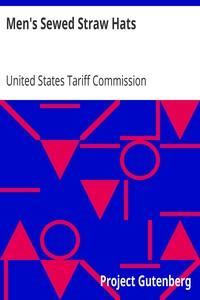|
|
Read this ebook for free! No credit card needed, absolutely nothing to pay.Words: 21528 in 4 pages
This is an ebook sharing website. You can read the uploaded ebooks for free here. No credit cards needed, nothing to pay. If you want to own a digital copy of the ebook, or want to read offline with your favorite ebook-reader, then you can choose to buy and download the ebook.

: Men's Sewed Straw Hats Report of the United Stated Tariff Commission to the President of the United States (1926) by United States Tariff Commission Coolidge Calvin Contributor - Hats; Straw industries@FreeBooksTue 06 Jun, 2023 Woven hats, such as panamas, etc. The bodies of these hats are imported in the rough and are shaped, finished, and trimmed in this country. Sewed hats. All of the operations necessary in the manufacture of a sewed straw hat, with the exception of plaiting the braids, are performed in the United States. This investigation relates to sewed hats only. The production of straw hats is to some extent seasonal. Orders are received in the late summer for delivery in the following spring. Production on these orders begins in September and the factories are usually busiest in the early months of the year. The summer is a slack season and factories operate with reduced labor force or close altogether for several weeks. The following table shows the monthly variations in the total number of employees of 18 domestic factories in the season 1923-24: IMPORTS The quantities and values of sewed straw hats imported into the United States were not separately shown in official statistics prior to the tariff act of 1922, in which sewed straw hats were given a separate classification. Table 3 shows the imports for consumption of sewed straw hats from the principal countries of origin, by months, for the calendar years 1923 and 1924. Total imports increased from 93,309 dozen in 1923, valued at 9,989, to 164,041 dozen in 1924, valued at ,179,929, a gain of approximately 75 per cent in quantity and 50 per cent in value. A comparison of the imports for the first four months of 1925 with those for the corresponding period in 1924 is shown in Table 4. A significant feature of this table is the increase in imports from Italy and the decrease of imports from both the United Kingdom and Germany. It should be noted also that the average foreign value per dozen of Italian hats decreased while the average foreign value of hats imported from England and other countries increased. In Table 5, imports of Italian hats at the port of New York in the six months January-June, 1924, have been classified according to foreign values shown on consular invoices. There is a marked concentration of imports in the value groups between and per dozen. About 90 per cent of all the sennit hats and 80 per cent of the total importations had foreign values of less than per dozen. The imports at the port of New York of hats from England are classified in Table 7. It is evident that the bulk of the English importations are not competitive with Italian hats. Only 28 per cent of the imports from England had a foreign value of less than per dozen. Representatives of the importers, on the other hand, called attention to the increasing competition of small firms in and around New York City with larger and longer established firms located principally in Baltimore. Some of the new firms operate on small capital and specialize in cheap hats which are directly competitive with the cheapest Italian hats. Others produce a somewhat better hat, such as is sold by chain stores. The rate of business failure among the newer firms is unusually high. Although the membership of the group of producers of cheap hats is fluctuating, its total output of hats each year is a factor in the competitive situation. A relatively new development in the distribution of straw hats is the chain stores. Sales of such stores, estimated at 150,000 to 200,000 dozen straw hats yearly, include Italian and English hats but are principally of domestic manufacture. In some cases a chain-store organization has established factories and thus has instituted direct competition with manufacturing firms already established. Chain stores also have furnished capital to small manufacturers, contracting for the bulk of their output. Thus the change in marketing methods has a bearing on the failure of the older establishments to keep pace in the volume of their sales with the national expansion in straw hat consumption. PRINCIPAL COMPETING COUNTRY Free books android app tbrJar TBR JAR Read Free books online gutenberg More posts by @FreeBooks
: Scottish Ghost Stories by O Donnell Elliott - Folklore Scotland; Ghost stories Scottish Horror@FreeBooksTue 06 Jun, 2023

: Quin by Rice Alice Caldwell Hegan - Courtship Fiction; World War 1914-1918 Veterans Fiction; Actors and actresses Fiction@FreeBooksTue 06 Jun, 2023
|
Terms of Use Stock Market News! © gutenberg.org.in2025 All Rights reserved.






